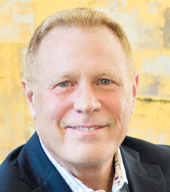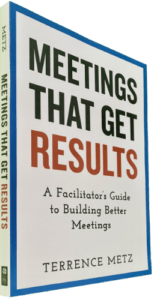There are good meetings and there are long meetings but there aren’t many good, long meetings. Therefore, Agile’s Daily Scrum event encourages self-evolving teams to meet daily, yet briefly. Strictly time-boxed to fifteen minutes duration, the Daily Scrum may also be called a morning roll-call, daily huddle, or a daily stand-up. Above all, you can use questions from a Daily Scrum to dramatically improve the quality of your regularly conducted staff meetings.
The Three Questions of a Daily Scrum
Daily Scrum meetings provide team members insight into where each other focuses their activities. For instance, you may use the trivium format of yesterday, today, and tomorrow to modify questions that meet your needs, as illustrated below.
Classic Three Questions of a Daily Scrum (simple variants)
- What did you do yesterday? (or, What did I accomplish yesterday?)
- What will you do today? (or, What will I do today?)
- Are there any impediments in your way? (or, What obstacles are impeding my progress?)
Motivational Version of the Three Questions of a Daily Scrum (implication)
- What did you do to change the world yesterday? (or, What did you accomplish since the last meeting?)
- How you are going to crush it today? (or, What are you working on until the next meeting?)
- How you are going to blast through any obstacles unfortunate enough to be standing in your way? (or, What is getting in your way or keeping you from doing your job?)
Comments About a Daily Scrum
Therefore, use the same approach for your weekly or monthly staff meetings. Although not exhaustive, the approach of reporting on Yesterday > Today > Obstacles prevents scope creep. Additionally, standing, rather than sitting, ensures that meetings remain brief and discourages wasted time.
The daily Scrum does not provide the time and place to solve problems. Rather, the daily Scrum approach makes the team aware of its current status. If discussion is needed, a longer meeting with appropriate parties can be arranged. Topics that require additional attention should be deferred until every team member has reported.
Agile’s Daily Scrum strives to disrupt old habits of working separately. Self-organizing teams radically outperform larger, traditionally managed teams. Groups optimally sized from five to nine members who . . .
- Commit to clear, short-term goals
- Gauge overall progress
- Observe each other’s contribution
- Provide each other with unvarnished feedback
Heterogeneous teams outperform homogeneous teams at complex work because they experience more conflict. An engaged team will disagree more frequently, indicating they are normal and healthy. Team performance will be determined by how well the team handles these conflicts.
Remember to have members focus on WHAT they are doing. Discussions about WHY they are doing it should be deferred to a planning meeting. Discussions about HOW they are doing it should be deferred to a design meeting or technical discussion.
For us, WHAT someone does remains abstract while HOW they do it becomes concrete. What we do in our daily lives is to ‘pay bills’. HOW we do that varies, such as writing cheques, submitting cash, etc.
The Nexus Daily Scrum Questions[1]
Using the Nexus framework, multiple development teams focus on the potentially shippable product increment and discuss:
- Was the previous day’s work successfully integrated? If not, why not?
- What new dependencies or impacts have been identified?
- What information needs to be shared across teams in the Nexus?
______
[1] 2018 Scrum.org. Offered for license under the Offered for license under the Attribution Share Alike license of Creative Commons, accessible at http://creativecommons.org/licenses/by-sa/4.0/legalcode and also described in summary form at http://creativecommons.org/licenses/by-sa/4.0/. By utilizing this Nexus Guide, you acknowledge and agree that you have read and agree to be bound by the terms of the Attribution Share-Alike license of Creative Commons.
______
Don’t ruin your career by hosting bad meetings. Sign up for a workshop or send this to someone who should. MGRUSH workshops focus on meeting design and practice. Each person practices tools, methods, and activities daily during the week. Therefore, while some call this immersion, we call it the road to building high-value facilitation skills.
Our workshops also provide a superb way to earn up to 40 SEUs from the Scrum Alliance, 40 CDUs from IIBA, 40 Continuous Learning Points (CLPs) based on Federal Acquisition Certification Continuous Professional Learning Requirements using Training and Education activities, 40 Professional Development Units (PDUs) from SAVE International, as well as 4.0 CEUs for other professions. (See workshop and Reference Manual descriptions for details.)
Want a free 10-minute break timer? Sign up for our once-monthly newsletter HERE and receive a free timer along with four other of our favorite facilitation tools.
______
With Bookmarks no longer a feature in WordPress, we need to append the following for your benefit and reference
- 20 Prioritization Techniques = https://foldingburritos.com/product-prioritization-techniques/
- Creativity Techniques = https://www.mycoted.com/Category:Creativity_Techniques
- Facilitation Training Calendar = https://mgrush.com/public-facilitation-training-calendar/
- Liberating Structures = http://www.liberatingstructures.com/ls-menu
- Management Methods = https://www.valuebasedmanagement.net
- Newseum = https://www.freedomforum.org/todaysfrontpages/
- People Search = https://pudding.cool/2019/05/people-map/
- Project Gutenberg = http://www.gutenberg.org/wiki/Main_Page
- Scrum Events Agendas = https://mgrush.com/blog/scrum-facilitation/
- Speed test = https://www.speedtest.net/result/8715401342
- Teleconference call = https://youtu.be/DYu_bGbZiiQ
- The Size of Space = https://neal.fun/size-of-space/
- Thiagi/ 400 ready-to-use training games = http://thiagi.net/archive/www/games.html
- Visualization methods = http://www.visual-literacy.org/periodic_table/periodic_table.html#
- Walking Gorilla = https://youtu.be/vJG698U2Mvo

Terrence Metz, president of MG RUSH Facilitation Training, was just 22-years-old and working as a Sales Engineer at Honeywell when he recognized a widespread problem—most meetings were ineffective and poorly led, wasting both time and company resources. However, he also observed meetings that worked. What set them apart? A well-prepared leader who structured the session to ensure participants contributed meaningfully and achieved clear outcomes.
Throughout his career, Metz, who earned an MBA from Kellogg (Northwestern University) experienced and also trained in various facilitation techniques. In 2004, he purchased MG RUSH where he shifted his focus toward improving established meeting designs and building a curriculum that would teach others how to lead, facilitate, and structure meetings that drive results. His expertise in training world-class facilitators led to the 2020 publication of Meetings That Get Results: A Guide to Building Better Meetings, a comprehensive resource on effectively building consensus.
Grounded in the principle that “nobody is smarter than everybody,” the book details the why, what, and how of building consensus when making decisions, planning, and solving problems. Along with a Participant’s Guide and supplemental workshops, it supports learning from foundational awareness to professional certification.
Metz’s first book, Change or Die: A Business Process Improvement Manual, tackled the challenges of process optimization. His upcoming book, Catalyst: Facilitating Innovation, focuses on meetings and workshops that don’t simply end when time runs out but conclude with actionable next steps and clear assignments—ensuring progress beyond discussions and ideas.




